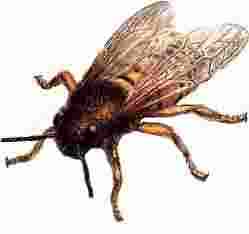Honey Bees
Honey Bee Information & Removal
 Size: 1/2-inch in length.
Size: 1/2-inch in length.
Colour: Golden-yellow in colour with darker bands of brown. Most everyone recognizes the honeybee common to any flowering garden.
Behaviour – Honeybees are the only type of social bee that establish perennial colonies that may survive a decade or longer. These bees forage on pollen and nectar from flowering plants and use these materials to produce the honey that will feed the colony through the winter months. Waxy honeycombs will fill the nest cavity, a fact that makes removal of honeybees from buildings a messy chore. All honeybee colonies produce queens and drones in the spring. These reproductives mate, and the queens may “abscond” with a number of workers to start new colonies. These swarms may be seen clustered on a tree branch, a fence, or a building as the bees rest before flying off again to find a suitable nesting site. Because hundreds of bees are part of this swarm, people are often concerned about the possibility of the bees attacking. Usually, the bees in these swarms are docile and non aggressive unless vigorously disturbed.
Habitat – In the wild, honeybees most often nest inside cavities within trees, but they will also nest within caves and cracks in rock formations. Occasionally, a colony will decide to nest inside a crawl space, an attic, a wall void, or a chimney in a home.
Tips for Control – Only experienced beekeepers and/or pest management professionals should be contacted to deal with colonies or swarms of honeybees. Never attempt to treat such nests without the proper training and equipment.
Once the colony inside a wall or attic has been eliminated, the building owner will need to open the wall and remove all the honey and honeycomb. If not removed, the honey will rot, produce strong odours and seeping stains, and will attract other insect pests.
